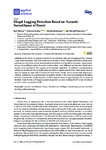Illegal Logging Detection Based on Acoustic Surveillance of Forest
| dc.contributor.author | Mporas, I | |
| dc.contributor.author | Perikos, I | |
| dc.contributor.author | Kelefouras, Vasileios | |
| dc.contributor.author | Paraskevas, M | |
| dc.date.accessioned | 2021-01-26T16:42:43Z | |
| dc.date.available | 2021-01-26T16:42:43Z | |
| dc.date.issued | 2020-10-21 | |
| dc.identifier.issn | 2076-3417 | |
| dc.identifier.issn | 2076-3417 | |
| dc.identifier.other | 0 | |
| dc.identifier.uri | http://hdl.handle.net/10026.1/16818 | |
| dc.description.abstract |
<jats:p>In this article, we present a framework for automatic detection of logging activity in forests using audio recordings. The framework was evaluated in terms of logging detection classification performance and various widely used classification methods and algorithms were tested. Experimental setups, using different ratios of sound-to-noise values, were followed and the best classification accuracy was reported by the support vector machine algorithm. In addition, a postprocessing scheme on decision level was applied that provided an improvement in the performance of more than 1%, mainly in cases of low ratios of sound-to-noise. Finally, we evaluated a late-stage fusion method, combining the postprocessed recognition results of the three top-performing classifiers, and the experimental results showed a further improvement of approximately 2%, in terms of absolute improvement, with logging sound recognition accuracy reaching 94.42% when the ratio of sound-to-noise was equal to 20 dB.</jats:p> | |
| dc.format.extent | 7379-7379 | |
| dc.language | en | |
| dc.language.iso | en | |
| dc.publisher | MDPI AG | |
| dc.subject | acoustic surveillance | |
| dc.subject | binary classification | |
| dc.subject | intelligent monitoring systems | |
| dc.subject | machine learning | |
| dc.subject | audio processing | |
| dc.title | Illegal Logging Detection Based on Acoustic Surveillance of Forest | |
| dc.type | journal-article | |
| dc.type | Journal Article | |
| plymouth.author-url | https://www.webofscience.com/api/gateway?GWVersion=2&SrcApp=PARTNER_APP&SrcAuth=LinksAMR&KeyUT=WOS:000585470000001&DestLinkType=FullRecord&DestApp=ALL_WOS&UsrCustomerID=11bb513d99f797142bcfeffcc58ea008 | |
| plymouth.issue | 20 | |
| plymouth.volume | 10 | |
| plymouth.publisher-url | https://www.mdpi.com/2076-3417/10/20/7379 | |
| plymouth.publication-status | Published online | |
| plymouth.journal | Applied Sciences | |
| dc.identifier.doi | 10.3390/app10207379 | |
| plymouth.organisational-group | /Plymouth | |
| plymouth.organisational-group | /Plymouth/Faculty of Science and Engineering | |
| plymouth.organisational-group | /Plymouth/Faculty of Science and Engineering/School of Engineering, Computing and Mathematics | |
| plymouth.organisational-group | /Plymouth/REF 2021 Researchers by UoA | |
| plymouth.organisational-group | /Plymouth/REF 2021 Researchers by UoA/UoA11 Computer Science and Informatics | |
| plymouth.organisational-group | /Plymouth/Users by role | |
| plymouth.organisational-group | /Plymouth/Users by role/Academics | |
| dcterms.dateAccepted | 2020-10-15 | |
| dc.rights.embargodate | 2021-1-28 | |
| dc.identifier.eissn | 2076-3417 | |
| dc.rights.embargoperiod | Not known | |
| rioxxterms.versionofrecord | 10.3390/app10207379 | |
| rioxxterms.licenseref.uri | http://www.rioxx.net/licenses/all-rights-reserved | |
| rioxxterms.licenseref.startdate | 2020-10-21 | |
| rioxxterms.type | Journal Article/Review |


